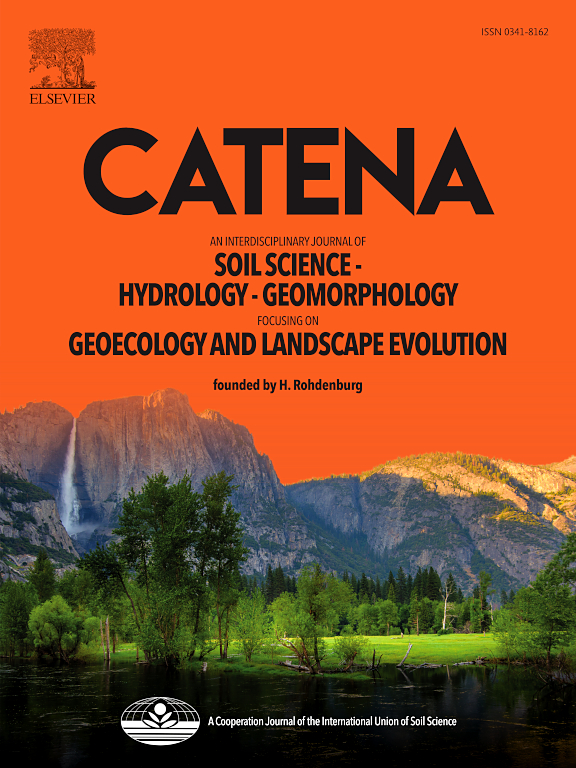山区集水区森林道路棱柱的土壤有机碳损失
IF 5.7
1区 农林科学
Q1 GEOSCIENCES, MULTIDISCIPLINARY
引用次数: 0
摘要
森林公路加剧了山区流域水土流失,严重影响了森林碳循环和生态功能。然而,有限的研究调查了这些环境中森林道路对碳损失的影响。研究了相岔沟流域不同侵蚀单元(上山坡、路面和路溪坡)的土壤有机碳(SOC)流失情况。我们还确定了影响有机碳损失的重要因素,并研究了它们之间的相互作用。研究结果表明,道路棱柱不同侵蚀单元的平均有机碳浓度在路面最低,而路面的有机碳损失量明显高于上坡。在不同流道中,沟道的平均有机碳浓度最低,但不同坡位流道间有机碳浓度无显著差异。这表明,在道路棱柱内的路面和沟壑上,土壤有机碳损失最为明显。相反,在部分沟壑区和扩散流道中,土壤有机碳损失随坡面位置变化显著,表明沟壑区的发育对道路-河流坡面土壤有机碳损失起关键作用。分段结构方程模型表明,上山坡面积、路面坡度、流道宽深比和粗糙度是影响道路棱柱内有机碳损失的重要因素(p <;0.05)。此外,上坡特征间接影响了路面和流道上的有机碳损失,而路面特征间接影响了流道沿线的有机碳损失。这些结果表明,森林道路造成的土壤有机碳损失不仅受路面的影响,还受不同侵蚀单元之间的相互作用的影响。为了减轻山区集水区的有机碳损失,应优先考虑管理具有广泛上山坡和发达沟壑的道路棱柱。本文章由计算机程序翻译,如有差异,请以英文原文为准。
Soil organic carbon loss from forest road prisms in a mountainous catchment
Forest roads exacerbate water and soil loss in mountainous catchments, significantly impacting forest carbon cycling and ecological functioning. However, limited research has examined the effect of forest roads on carbon loss in these environments. In this study, we investigated soil organic carbon (SOC) loss across different erosion units (upper hillslopes, road surfaces, and road-stream slopes) within road prisms in the Xiangchagou catchment, China. We also identified the significant factors influencing SOC loss and examined their interactions. Our findings revealed that the average SOC concentrations of different erosion units in road prisms were lowest in road surfaces, where SOC losses were significantly higher than on upper hillslopes. Among different flow paths, gullies exhibited the lowest average SOC concentration, but no significant differences were observed between flow path SOC concentrations at different hillslope positions. This suggests that SOC loss is most pronounced on road surface and gullies within road prisms. In contrast, SOC loss varied significantly with hillslope positions in both partially gullied and diffused flow paths, indicating that gully development plays a critical role in determining SOC loss on road-stream slopes. Piecewise structural equation modeling showed that upper hillslope area, road surface slope, flow paths width-to-depth ratio, and roughness were significant factors influencing SOC loss within the road prism (p < 0.05). Additionally, upper hillslope characteristics indirectly influenced SOC loss on road surfaces and flow paths, while road surface characteristics indirectly influenced the SOC loss along flow paths. These findings suggest that SOC loss induced by forest roads is driven not only by road surfaces but also by interactions among different erosion units. To mitigate SOC loss in mountainous catchments, priority should be given to managing road prisms with extensive upper hillslopes and well-developed gullies.
求助全文
通过发布文献求助,成功后即可免费获取论文全文。
去求助
来源期刊

Catena
环境科学-地球科学综合
CiteScore
10.50
自引率
9.70%
发文量
816
审稿时长
54 days
期刊介绍:
Catena publishes papers describing original field and laboratory investigations and reviews on geoecology and landscape evolution with emphasis on interdisciplinary aspects of soil science, hydrology and geomorphology. It aims to disseminate new knowledge and foster better understanding of the physical environment, of evolutionary sequences that have resulted in past and current landscapes, and of the natural processes that are likely to determine the fate of our terrestrial environment.
Papers within any one of the above topics are welcome provided they are of sufficiently wide interest and relevance.
 求助内容:
求助内容: 应助结果提醒方式:
应助结果提醒方式:


